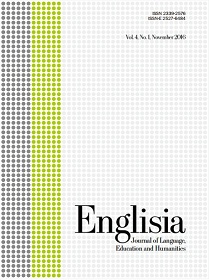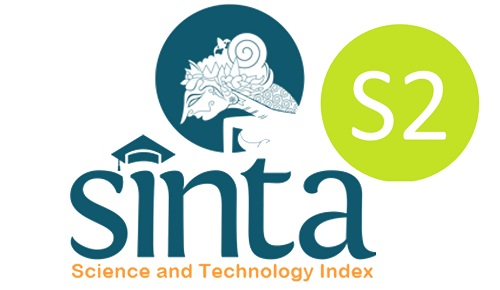ENGLISH INSTRUCTION FOR EARLY-CHILDHOOD EDUCATION (A CASE STUDY AT TK RIYADUL JANNAH SIMO BOYOLALI CENTRAL JAVA YEAR 2016)
DOI:
https://doi.org/10.22373/ej.v4i1.1246Keywords:
Stakeholders Condition, English Instruction, KindergartenAbstract
Kindergarten children are creative, resourceful, and imaginative. During the kindergarten years, the children’s perceptual skills can be sharpened by encouraging them to observe specific aspects of their environment. In line with the need of English as the international and the most spoken language, English subject is being taught to students from elementary to university level, or even to kindergarten. The consideration is that English should be taught very early as the students will easily absorb the English materials later on. However, kindergarten teachers in Indonesia are actually not the experts of the field. There are still limited graduated teachers majoring in kindergarten or early childhood education department. Promoting an effective learning can only be well done by teachers who are qualified enough. In addition, there is no best method in teaching such a foreign language to these young students. To sum up, teaching a foreign language to very young students who are living in and accustomed to the first language is a challenging task for the kindergarten teachers.Downloads
References
Bandura, A. 1971. An analysis of modelling process. In Bandura, A. (ed.) Psychological Modelling. New York: Lieber-Atherton.
Borisch, Gary D. 2007. Effective teaching methods: research-based practice (6th Ed.). Ohio, USA: Merill Prentice Hall.
Bryant, P.E., Maclean, M., & Bradley, L. 1990. Rhyme, language, and children’s reading. Applied Psycholinguistics, 11, 3, 237-52.
Cabello, B., & Terrel, R. 1994. Making students feel like family: How Teachers Create warm and Caring Classroom Climates. Journal of Classroomm Interaction, 29, 17-23.
Cameron, L. 2003. Challenges for ELT from the Expansion in Teaching Children. ELT Journal 57/2.
Clark, C. & Peterson, P. 1986. Teachers’ Thoughts Process.
Dardjowidjojo, Soenjono. 2005. Psikolinguistik: Pengantar Pemahaman Bahasa Manusia (edisi kedua). Jakarta: Yayasan Obor Indonesia.
Gebhard, J.G., S. Gaitan & R. Oprandy. 1990. Beyond prescription: the student teacher as investigator. In Richards, Jack C and Nunan, D. (eds). Second Language Teacher Education Cambridge : Cambridge University Press
Good, T., & Brophy, J. 2003. Contemporary Educational Psychology (5th ed.). New York: Longman.
Goldhaber, D., & Anthony, E. 2003. Indicators of Teacher Quality. New York: Eric Clearing house on Urban Education.
Harmer, J. 2004. the Practice of English Language Teaching. Cambridge, UK: Longman.
Kagan, D., & Tippins, D. 1992. The Evolution of Functional Lesson Plans among Twelve Elementary and Secondary Student Teachers. Elementary School Journal, 92 (4), 447-489.
Klapper, J. (ed). 2001. Teaching Languages in Higher Education. London: CILT.
Krashen, S. 1982. Principles and Practice in Second Language Learning and Acquisition. Oxford: Pergamon
Krashen, S. & Terrell, T.D. 1983. The Natural Approach. Oxford: Pergamon
Kuh, G., Kinzie, J., smith, J., & Whitt, E. 2005. Assessing Condition to Enhance Educational Effectiveness: The Inventory for Students Engagement and Success. San Fransisco, NY: Merrill Prentice Hall
Levis, D. S. 1987. Teachers Personality. In M.J. Dunkin (Ed.), Encyclopedia of Teaching and Teacher Education (pp. 585-588). New York: Pergamon.
Skinner, B.F. 1953. Science and Human Behavior. Upper saddle River, NJ: Merrill Prentice Hall.
Smith, P.K., Cowie, H., & Blades, M. 2003. Undestanding Children’s Development. UK: Blackwell Publishing.
Downloads
Published
Issue
Section
License
Proposed Policy for Journals That Offer Open Access
Authors who publish with Englisia journal agree to the following terms:
- Authors retain copyright and grant the journal right of first publication with the work simultaneously licensed under a Creative Commons Attribution License that allows others to share the work with an acknowledgement of the work's authorship and initial publication in this journal.
- Authors are able to enter into separate, additional contractual arrangements for the non-exclusive distribution of the journal's published version of the work (e.g., post it to an institutional repository or publish it in a book), with an acknowledgement of its initial publication in this journal.
- Authors are permitted and encouraged to post their work online (e.g., in institutional repositories or on their website) prior to and during the submission process, as it can lead to productive exchanges, as well as earlier and greater citation of published work (See The Effect of Open Access).









